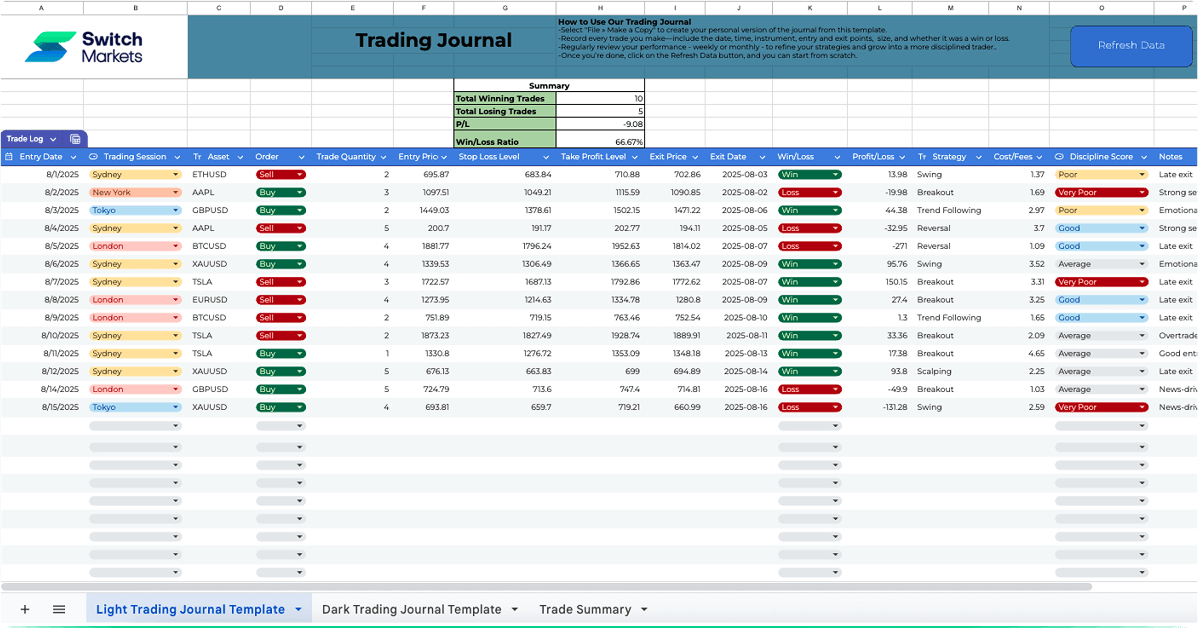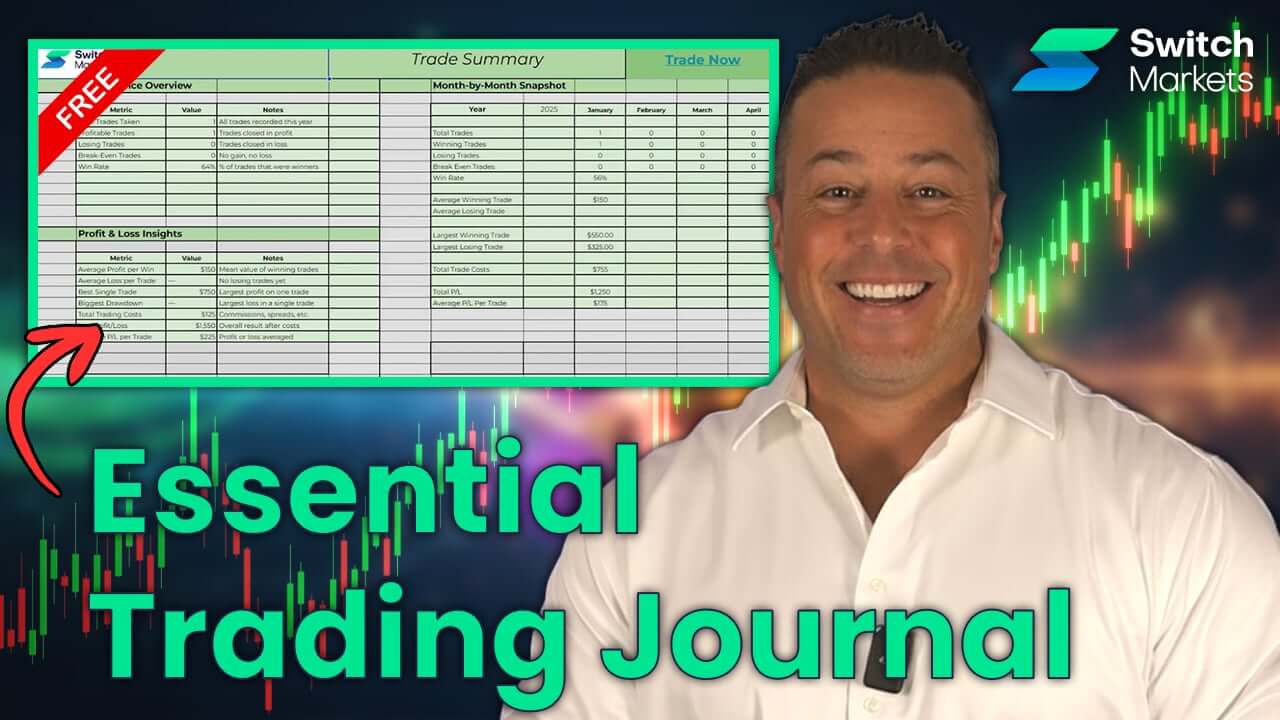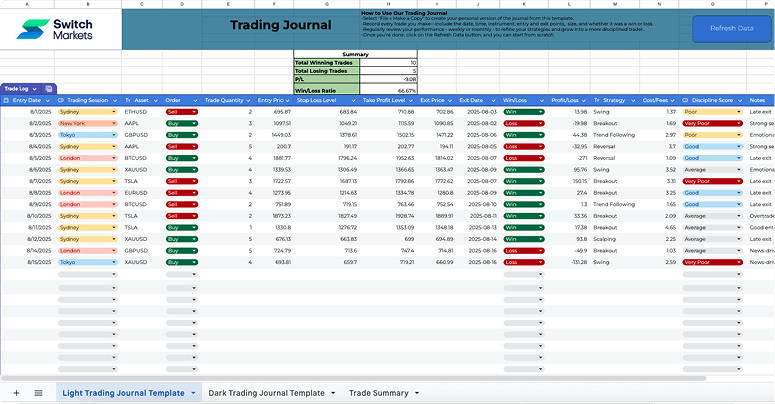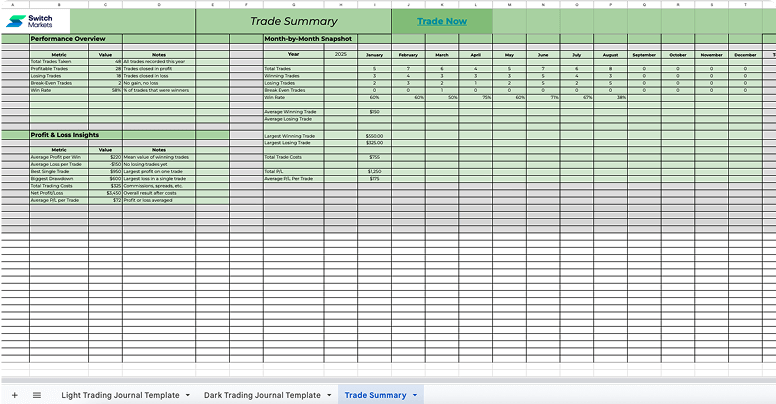Up to $5,000 Bonus this Black Friday
Free Trading
Journal Template
A trading journal template isn’t just a spreadsheet; it’s your personal playbook for mastering the markets. It’s where every trade gets recorded, reviewed, and transformed into insights you can act on. With this journal, you'll be able to bring your ambition into focus.


Inside, You’ll Typically Log
Date & Time
So you know exactly when the action happened.
Instrument
Whether it’s EUR/USD, S&P 500, or your favorite stock.
Position Size
The muscle behind your move.
Entry & Exit Prices
Your battlefield markers for entry and exit points.
Stop Loss & Take Profit Levels
Your safety net and victory line.
Trading Session
To learn in which session you perform best.
Reason for Entry
The strategy or signal that got you in the game.
Cost/Fees
The total trading costs for a chosen period.
Win–Loss Ratio
To measure your performance and improve your trade discipline.
Discipline Score
To monitor your discipline performance and enhance trading rules.
Notes
Your observations, emotions, and lessons learned along the way.
Additionally, our trading journal also includes a trade summary that can help you track your month-by-month performance.
Done right, a trading journal becomes more than a record; it’s your performance coach, helping you spot trading patterns, analyze key metrics, fine-tune trading edge, and level up your trading game.
Our Free Trading Journal Templates
Here’s a free downloadable and easy-to-use trading journal template in MS Excel format. Simply make a copy, add as many rows as your trading style requires, and export it anytime as your own customized Microsoft Excel trading journal.

Why Is a Trading Journal Essential?
A trading journal isn’t just a log of your trades; it’s your personal roadmap to becoming a smarter, more disciplined trader.
By recording every trade, you gain clarity on what’s working, what’s costing you money, and how your emotions impact your decisions. Over time, you’ll spot patterns, refine your strategy, and cut out costly mistakes.
Think of it as your trading “black box”; the more trade data you feed it, the better insights you’ll get, and the faster you’ll grow as a trader.
How to Use Our Trading Journal Templates
Getting started couldn’t be simpler
-
1: Grab your copy
Click the link to our free trade journal template. Then head to 'File' → 'Make a copy' to save your editable version to your Drive. Prefer to keep it local? Choose 'File' → 'Download' and grab it as Excel or OpenDocument.
-
2: Know your tools
Use the tabs to navigate. Tab 1 is your 'Light Trading Journal Template'. Tab 2 is your 'Dark Trading Journal Template'. Tab 3 is your Trade Summary, where you can monitor performance and get a month-by-month snapshot.
-
3: Log like a pro
Every time you open a trade, jump to the ‘Trade Log’ tab. Record the basics - date, symbol, long/short/open - plus entry trade details like price, time, size, and stop loss. During the trade, jot down notes in our trading journal columns: strategies, market vibes, or your mindset that day.
-
4: Wrap it up
When the trade closes, fill in the exit details and commission. Your P/L, Win/Loss, and R-Multiple will auto-calculate. Finally, use column O to lock in the discipline score - this is where growth happens. It’s not just a journal, it’s your trading blueprint. The more you use it, the sharper you get.

Frequently Asked Questions
Read our frequently asked questions below. If you still need help, contact us today.
01 Can a trading journal help you become a better trader? Absolutely, a trading journal can be one of the most powerful tools in your trading arsenal.
By tracking every trade, along with your reasoning, emotions, and outcomes, you start to see patterns you might otherwise miss. You’ll spot what works, identify costly mistakes, and refine your strategy over time. It’s like having a personal coach who never forgets a single detail of your trading history.
Absolutely, a trading journal can be one of the most powerful tools in your trading arsenal. By tracking every trade, along with your reasoning, emotions, and outcomes, you start to see patterns you might otherwise miss. You’ll spot what works, identify costly mistakes, and refine your strategy over time. It’s like having a personal coach who never forgets a single detail of your trading history.
02 How often should you review your trading journal? You should review your trading journal spreadsheet regularly, ideally after every trading week or month, to identify patterns, learn from mistakes, and adjust your strategy. Consistent review helps keep your trading disciplined and continuously improving.
You should review your trading journal spreadsheet regularly, ideally after every trading week or month, to identify patterns, learn from mistakes, and adjust your strategy. Consistent review helps keep your trading disciplined and continuously improving.
03 What information does a trade journal include?
A trade journal captures key details like the date, instrument, position size, entry and exit prices, and stop loss/take profit levels. It also records your reasons for entering a trade, the outcome, and notes on market conditions and emotions. This helps you track performance, manage risk, and sharpen your trading strategy over time.














